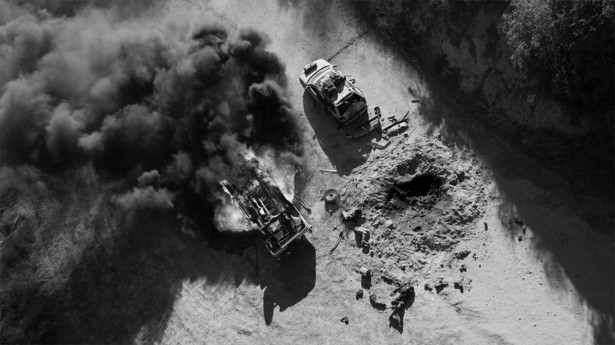Omer Fast
22 Oct - 18 Dec 2011

Omer Fast, Feet is the Best, 2011
Digitaler Film, 27 min. Still: Yon Thomas
Courtesy gb agency, Paris und Arratia, Beer, Berlin
Digitaler Film, 27 min. Still: Yon Thomas
Courtesy gb agency, Paris und Arratia, Beer, Berlin
In his solo show at Kölnischer Kunstverein Omer Fast will be presenting his new work 5000 Feet is the Best (2011) as well as the three-part video work Nostalgia (2009). Omer Fast (*1972) is well known for film and video works that employ formal strategies of film and TV such as mixing documentary and fictitious material, playing with sound, image, cut and truisms of film history. The plurality of perspectives and voices he integrates into his stories in this way negate the authentic. His films are works on the possibilities and potentials of story-telling.
5000 Feet is the Best tells a story about pilots of unmanned, American drones who work in container-like offices surrounded by a multitude of computer displays. Technology allows them to discern what make someone’s shoes are or to watch a man smoking his cigarette from the other end of the world – it is a very intimate visual perception, a sensation the pilot also feels when he directs the drone’s missiles to their target. The digital film, which is based on an interview by the artist with a former pilot, mixes documentary material with fictitious elements. The pilot evades the questions of the interviewer time and again and seeks refuge in the recounting of petty anecdotes. The images these stories conjure up in the film blend with our own imaginings of the war in the Middle East and those of Las Vegas. Increasingly, the film focuses on the void between our own media-shaped assumptions and the traumatizing experiences of the pilot.
Nostalgia, a work made in 2009, is a video installation in three parts. Based on an audio recording of a conversation with a refugee from Nigeria a story about illegal immigrants and the tightly controlled border between Africa and Europe develops. Nostalgia consists of a short documentary video, a two-display installation showing a staged interview situation between an African and a director and a science fiction set in the past picturing Europeans fleeing a ruined and insecure Europe for a safe Africa via an underground tunnelling network. Similar to Joseph Conrad’s novel Heart of Darkness the narrative structure of Nostalgia is build up like a Russian Matrjoschka doll that reveals the planes of narration one by one.
In the first part of Nostalgia the African interviewed by Omer Fast recounts how, when he was a child soldier, he was taught by a senior soldier to trap partridges. In the subsequent parts of the installation actors acting out different characters describe precisely this laying of the snare trap. The more the viewer penetrates the manifold perspectives and planes of reality the more the snare seems to close in on him.
5000 Feet is the Best tells a story about pilots of unmanned, American drones who work in container-like offices surrounded by a multitude of computer displays. Technology allows them to discern what make someone’s shoes are or to watch a man smoking his cigarette from the other end of the world – it is a very intimate visual perception, a sensation the pilot also feels when he directs the drone’s missiles to their target. The digital film, which is based on an interview by the artist with a former pilot, mixes documentary material with fictitious elements. The pilot evades the questions of the interviewer time and again and seeks refuge in the recounting of petty anecdotes. The images these stories conjure up in the film blend with our own imaginings of the war in the Middle East and those of Las Vegas. Increasingly, the film focuses on the void between our own media-shaped assumptions and the traumatizing experiences of the pilot.
Nostalgia, a work made in 2009, is a video installation in three parts. Based on an audio recording of a conversation with a refugee from Nigeria a story about illegal immigrants and the tightly controlled border between Africa and Europe develops. Nostalgia consists of a short documentary video, a two-display installation showing a staged interview situation between an African and a director and a science fiction set in the past picturing Europeans fleeing a ruined and insecure Europe for a safe Africa via an underground tunnelling network. Similar to Joseph Conrad’s novel Heart of Darkness the narrative structure of Nostalgia is build up like a Russian Matrjoschka doll that reveals the planes of narration one by one.
In the first part of Nostalgia the African interviewed by Omer Fast recounts how, when he was a child soldier, he was taught by a senior soldier to trap partridges. In the subsequent parts of the installation actors acting out different characters describe precisely this laying of the snare trap. The more the viewer penetrates the manifold perspectives and planes of reality the more the snare seems to close in on him.
